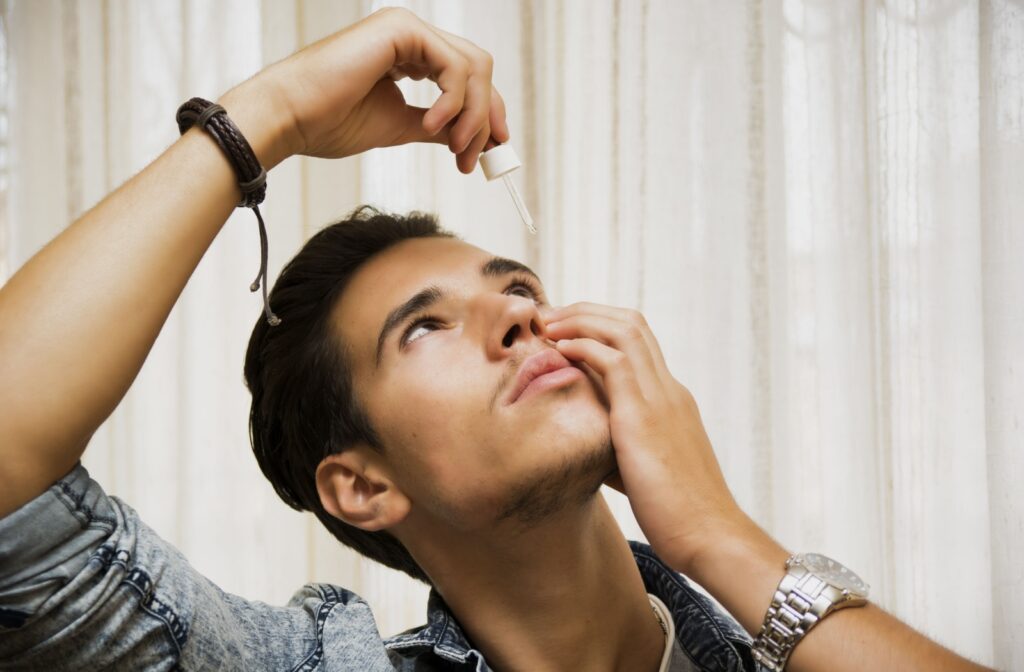Battling the persistent, prickling itch of dry eyes can be more than an inconvenience; it can affect how we work, learn, and enjoy life. Once the discomfort sets in, one of the first lines of defense is artificial tears.
However, its important to understand when and how often because, surprisingly, you can actually cause negative effects on your eye if you overuse them. How often you can use eye drops depends on the type you’re using. You can use preservative-free artificial tears as much as you want, but eye drops with preservatives should only be used 4 times a day max and prescription eye drops should only be used as directed.
Fortunately, your optometrist is here to help you navigate the world of dry eye relief!
What Is Dry Eye?
Dry eye is a common condition that happens when your tears can’t provide adequate lubrication for your eyes. This can happen because you simply don’t make enough tears or because your tears are low quality. Yep, that’s right. You can have low-quality tears. This is because tears aren’t just salty water. They’re a collection of essential nutrients that protect your eyes while keeping them healthy.
Low quality can mean your tears evaporate too quickly and is often the result of meibomian gland dysfunction (MGD). In fact, a staggering 85% of all dry cases are due to MGD. This is where the glands responsible for producing the oily part of the tear film become blocked, reducing the eye’s natural defense mechanism.
Dry eye isn’t just about moisture. You may notice symptoms such as:
- Gritty, burning, or stinging sensation
- Increased sensitivity to light
- Eye redness
- Feeling like something is in your eye
- Difficulty wearing contact lenses
- Blurry vision
- Watery eyes—which seems counterintuitive until you understand this is a sort of panic-mode response from the eye to lack of moisture
If you experience any of these symptoms, your optometrist can help determine if dry eyes are to blame and how to find relief.
Using Dry Eye Drops Properly
We’re primed to think that if a little relief is good, a lot must be better—but here’s where the narrative gets a bit complicated concerning dry eye drops. Much of this comes down to what type of eye drop you’re using.
Lubricating eye drops—another name for artificial tears—come in 2 broad types:
- Eye drops with preservatives: Some eye drops have chemicals that help keep bacteria from growing inside the bottle once opened. While this can limit the risk of eye infection and provide longer-lasting bottles, some people find preservatives irritate their eyes.
- Preservative-free eye drops: As you may expect, preservative-free eye drops have little to no preservatives. They don’t last as long as other eye drops (sometimes only as little as 24 hours), but some users find them gentler.
Always check your bottle’s instructions to see what the manufacturer recommends. Most eye doctors recommend not using drops with preservatives more than 4 times daily.
If you’re using preservative-free eye drops, you’re usually safe to use them as much as you need to during the day. However, using artificial tears consistently may indicate that you require more advanced treatment.
What About Medicated Eye Drops?
Moderate to Severe dry eye may require something with a bit more strength and targetted effect. Medicated eye drops are prescribed by an optometrist and can provide the same rapid relief artificial tears do. However, they can also stimulate tear production, giving long-term relief.
Medicated eye drops may contain ingredients like antihistamines or steroids and should be used sparingly and only under a doctor’s instruction due to potential side effects.
Other Ways to Treat Dry Eyes
Your eye dropper isn’t your only ally in the fight against irritation. So if you find you’re reaching for your bottle too frequently, your optometrist might recommend other treatments, including:
- Warm compresses: A warm compress can help to ease the blockage of meibomian glands and enhance the quality of meibum, the oily layer of the tear film. Bruder masks can be tossed in the microwave as a convenient way to melt blockages at home.
- Omega-3 supplements: Some research has shown a connection between consuming omega-3 fatty acids and easing dry eye symptoms. It can be found naturally in fish, nuts, and plant oils, but some take supplements to boost their intake.
- Radiofrequency (RF) therapy: Your optometrist can use a radiofrequency device such as TempSure to create a gentle heat that helps melt meibomian gland blockages. While originally for skin care, RF therapy has found a home in dry eye relief.
- Intense pulsed light (IPL) therapy: IPL therapy uses a specific wavelength of light to combat inflammation and the root cause of your symptoms, meibomian gland dysfunction.
- Thermal pulsation: iLux thermal pulsation system uses heat and gentle massage to clear out meibomian gland blockages.
The right treatment for you depends on your symptoms, and it all starts with a chat and an eye exam.
Dry Eye Relief Is Within Reach
Remember, each pair of eyes and their treatment plan are unique. Don’t hesitate to reach out to a professional for tailored advice. At In Focus Eyecare, we’re dedicated to guiding you through the intricate landscape of eye health, promoting a vision for a brighter, more vibrant life. Our online dry eye assessment can help you recognize your symptoms.If you’re ready to take the next step towards comfortable vision, book your dry eye exam now and see the world through a brighter lens!





